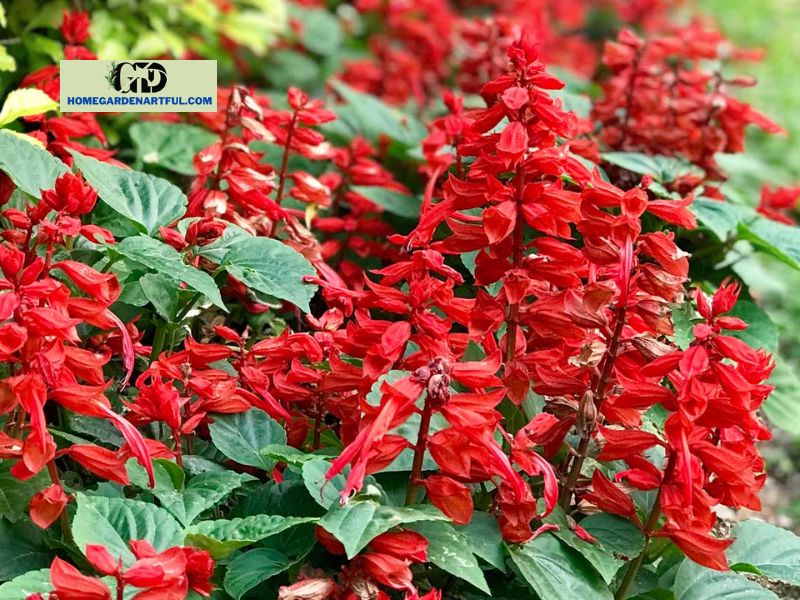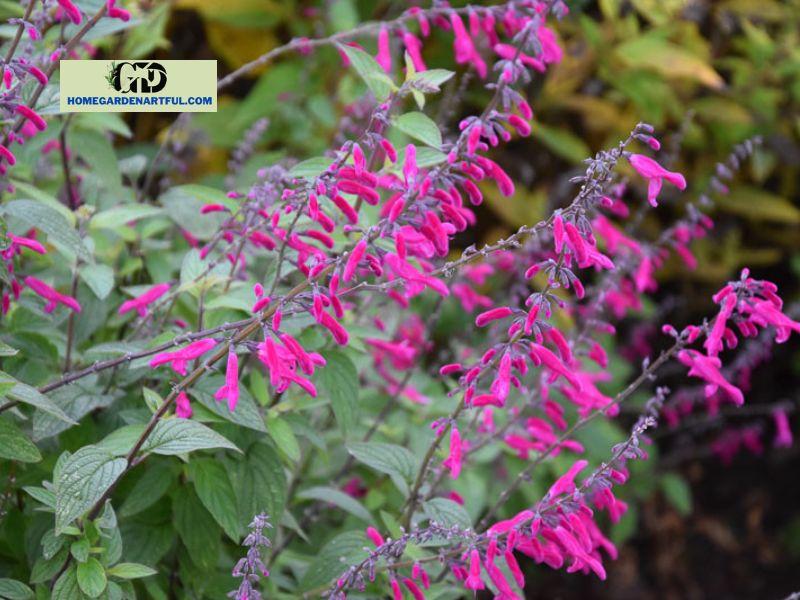Do you know Salvia Wendy’s Wish? If you’re looking for plants that flower all year with minimal care, keep reading. The salvia family contains approximately 500 members, all of which look stunning in the sun.
Salvias are divided into four types: annuals, biennials, perennials, and herbaceous shrubs. They are tough plants that thrive in either rubbly clay or friable loam as long as they are well-drained. There are around 500 kinds of Salvias, ranging from edible sages to small to giant bushes reaching 3m in height. There is a Salvia for every temperature, season, and garden design. Most Salivas display their flowers best from April to autumn.
Salvias are easily propagated by either sowing seeds (for annual varieties) taking cuttings or dividing old clumps (for biennial, perennial, and herbaceous varieties). Discover at homegardenartful.com!
Salvia Wendy’s Wish planting and care

Plant salivas in large quantities for a vibrant display of color in garden beds, or choose smaller, more compact kinds for pot displays around patios and entertainment areas. Most want full light and well-drained soil. 5in1 Organic Fertiliser should be mixed into the soil before planting for robust, healthy foliage and flower show. An occasional application of soluble fertilizer, such as Searles Flourish Soluble Plant Food, will maintain the plants flowering at their best, but too much nitrogenous food will result in excessive foliage at the price of blooms.
They can withstand moderate droughts, but in poor soils, it is best to protect their roots with mulch during lengthy periods of hot and dry weather.
Annual and perennial varieties can be clipped after flowering to remove dead flowers and rebalance top-heavy plants, whilst larger shrubby varieties can be pruned to 45cm from the ground in autumn, after when they will produce fresh new growth nearly immediately.
Salvias Come in a Variety of Colors
The showiest and most well-known of all the salvias is the brightly colored red bedding variety Salvia splendens, with cultivar names like ‘Blaze of Fire’, ‘Fireball’ and ‘Bonfire’. It is native to Brazil, as are most of the showiest garden plants, and it represents tropical and subtropical gardening in Australia. Salvia splendens grows to around 45cm in height and, while commonly grown as an annual, can be treated as a perennial in all but the coldest areas. Its huge flower spikes bloom all year, particularly if the old ones have been eliminated as they decline. Salvia splendens and cultivars self-seed profusely, which is helpful if you want to bulk up your stock for free or when you need to replace ailing plants.
Some newer kinds, such as Salvia ‘Heatwave’ and ‘Wish’ Collection, are more compact with a more rounded canopy and prefer to flower during the warmer months, making them ideal for small gardens and patio pots over the holiday season.
Varieties that bloom in the winter

At last, a plant that not only adds vibrant color to the yard but also adds a lovely perfume should be considered. Salvia dorisiana ‘Fruity Sage’ is a winter flowering salvia that is a sensory delight on two levels. The beautiful pink blossoms that develop from late June to early October are a genuine bright spark in the garden and honeyeaters of all kinds like them.
The aroma, on the other hand, is released by the big, hairy (evergreen) leaf and smells like fruit salad, giving rise to its other popular name of ‘Fruit salad sage’. This salvia thrives in moderate shade with moisture-retaining soil. Strong trimming is advised at the conclusion of its flowering season, when it will recover fast by sprouting luxuriant new foliage.
Special effects
Many salvias feature unique foliage, such as S. officinalis ‘Tricolor’ with pinkish cream mixed grey variegations or S. officinalis ‘Purpurea Variegata’ with dark purple leaves.
The Mexican bush sage, S. leucantha, has virtually pure white stems and underleaves that contrast beautifully with the purple and white fuzzy blooms.
Salvia blooms are available in a variety of colors, including violets, yellows, maroons, pinks, blues, purples, whites, creams, and greens. As if that weren’t enough, certain salvias, such as S. ‘Black Knight,’ produce persistent calyces that are as colorful, if not more so, compared to the flowers they support, giving the plant a vivid two-tone impression.
Sages that can be eaten

Salvia officinalis, sometimes known as garden sage, was found by medieval gourmets to be a multi-purpose culinary plant. It went well with meats and was the star of stuffings when paired with parsley, rosemary, and thyme. It was frequently employed as a digestive aid for fattier types of meat like geese and hog. Its pungent flavor enhances stews, pates, salads, smallgoods, soups, and cheeses, and the dried leaves can be blended into a soothing tea.
Origin of the Name
Salvia is derived from the Latin salvare, which refers to the plant’s power to cure. Sage was used by ancient herbalists to treat everything from snake stings to epilepsy. The popular name for S. sclarea ‘Clary sage’ comes from its supposed ability to improve vision. S. officinalis has recently gained popularity as a natural antibacterial and mouthwash for throat discomfort and gum problems. Sage wine was used as a tonic for the body and mind, whereas sage beer was notoriously intoxicated.
Salvias is quickly establishing a reputation for its variety, value, and adaptability. Why not give them a try if you have a sunny spot?


